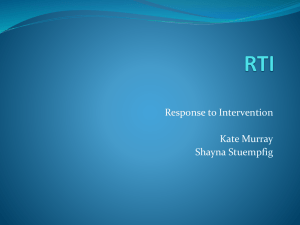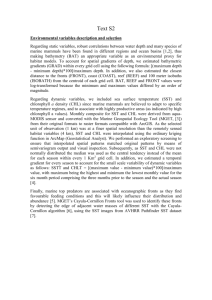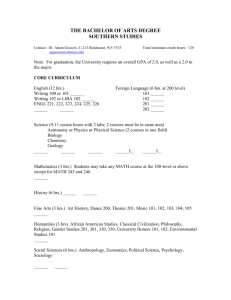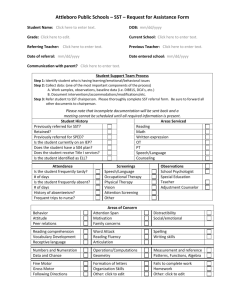Student Support Team (SST) building leader – oversees the RtI
advertisement
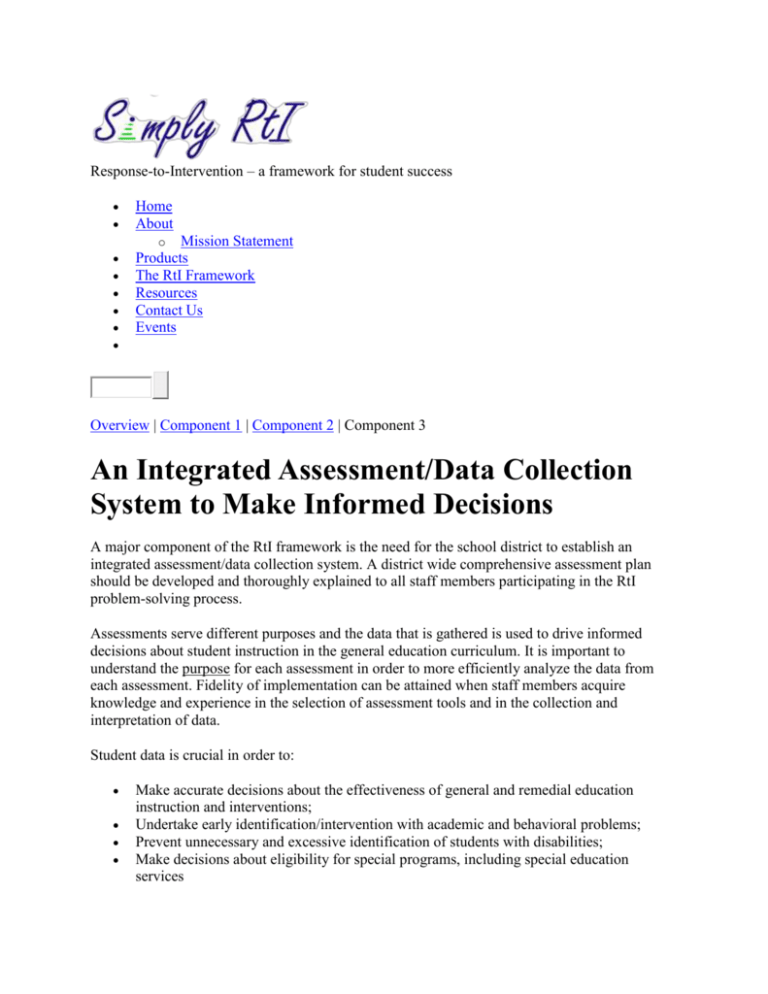
Response-to-Intervention – a framework for student success Home About o Mission Statement Products The RtI Framework Resources Contact Us Events Overview | Component 1 | Component 2 | Component 3 An Integrated Assessment/Data Collection System to Make Informed Decisions A major component of the RtI framework is the need for the school district to establish an integrated assessment/data collection system. A district wide comprehensive assessment plan should be developed and thoroughly explained to all staff members participating in the RtI problem-solving process. Assessments serve different purposes and the data that is gathered is used to drive informed decisions about student instruction in the general education curriculum. It is important to understand the purpose for each assessment in order to more efficiently analyze the data from each assessment. Fidelity of implementation can be attained when staff members acquire knowledge and experience in the selection of assessment tools and in the collection and interpretation of data. Student data is crucial in order to: Make accurate decisions about the effectiveness of general and remedial education instruction and interventions; Undertake early identification/intervention with academic and behavioral problems; Prevent unnecessary and excessive identification of students with disabilities; Make decisions about eligibility for special programs, including special education services Determine individual education programs and deliver and evaluate special education services. (National Association of State Directors of Special Education NASDE , 2008) There are four categories of assessments contained in a comprehensive assessment plan: Screening assessments – quick and efficient measures that are administered to all students in the fall, winter and spring. Screening assessments are used to assess academic and behavioral strengths and needs of all students. Schools can use the data to establish local norms. The local norms can be compared to district, state and national norms to determine a rate of increase in student performance. For example, The Dynamic Indicators of Basic Early Literacy Skills (DIBELS) benchmark assessment is a screening tool used to determine if students may be at-risk for developing essential early reading skills. It provides national norms. Progress monitoring assessments – brief assessments that are used to continuously evaluate the effectiveness of instruction and to determine students’ rate of progress. For example, a running record may be administered to determine if a student’s reading level needs to be adjusted. Progress monitoring is ongoing at each tier where a student’s level of performance and rate of progress is tracked. A change in level of intensity, frequency and duration of the intervention is made for students who do not make the expected rate of progress. Diagnostic assessments – in-depth assessments administered to selected students in order to identify the specific area of weakness. For example, if the student is struggling with vocabulary, The Peabody Picture Vocabulary Test (PPVT) may be administered to help plan more intensive interventions. Outcome-Based Assessments – provide summative data on broad abilities and is closely related to expected grade-level content standards. An outcome-based assessment looks at student performance to see what the students can actually do after they are taught. For example, The Michigan Education Assessment Program (MEAP) is administered in October. The data is used by school leaders as feedback about the overall effectiveness of their instructional program. By designing an integrated assessment/data collection system as part of the RtI instructional framework, the school staff will be able to understand the purpose of the assessment tool being selected, the kind of data that is being collected, and how often to look at the data for each student. Below is a sample of a school district’s comprehensive assessment plan for grades K-6 (Table 1).* * Table is adapted from Idaho Department of Education Component 3. A Problem-Solving Method Used to Develop Intervention Plans Implementing an RtI framework provides a continuum of school-wide support. Its core principles are that core instruction is provided with fidelity, student progress is monitored frequently, students’ responsiveness to intervention is evaluated, and instruction is adapted as needed. (National Association of State Directors of Special Education, 2005). The core principles of RtI are implemented through a carefully designed problem-solving method. The important steps found in a problem-solving method are: 1. 2. 3. 4. 5. Define the problem Analyze the cause Develop the plan Implement and monitor the plan Evaluate the plan These steps are shown in Figure 2 below. Figure 2. The Problem-Solving Method. In a true problem-solving method, an individual student’s failure to respond to interventions is addressed and an individual plan is tailored to meet his/her needs. A second approach is the standard-protocol method. Standardized protocols or specific instructional programs are developed and implemented using prescribed procedures that are implemented for a specific length of time. A third option is the blended approach. As part of this method, the five problem-solving components are utilized along with standard protocols. Establishing a Student Support Team Collaboration among school professionals is crucial to the successful implementation of the RtI framework. Establishing a team of school staff members who effectively communicate and understand the key components of RtI leads to improved educational outcomes for all students. Different teams may exist in each school building. These include the School Improvement Team, Grade-level Teams, Multidisciplinary Teams and Student Support Teams. It is the function of the Student Support Team to review student performance data and to make collaborative decisions regarding each student’s level of support. The Student Support Team (SST) should be comprised of school staff members from different departments. Team members may shift roles throughout the year but key members include: Building administrator – actively supports the Student Support Team by scheduling and/or attending meetings, communicating with team members regularly, and monitoring fidelity of instruction/interventions. Student Support Team (SST) building leader – oversees the RtI problem-solving process at the school. The SST building leader monitors data collection, particularly progress monitoring, collects SST forms and acts as liaison between the general education and special education departments as students move through the tiers of support. Classroom teacher – differentiates instruction, administers benchmark and progress monitoring assessments, identifies at-risk students, communicates with parents and SST regarding student concerns, completes SST forms, attends SST meetings and actively participates in developing and implementing the SST Intervention Plans. Intervention specialist – member of Student Support Team who provides targeted interventions to a student or a group of students and is also responsible for collecting benchmark and progress monitoring data. Parent(s)/legal guardians – communicates and shares information pertaining to their child with the SST, attends SST meetings and participates in developing and implementing the SST Intervention Plan. School specialists – team members who may become involved at the different tiers of support. The school specialist may be asked to administer student assessments, provide consultation services, implement interventions, or assist families throughout the RtI process. These specialists include: school counselors school psychologists schoolsocial workers speech and language pathologists reading and math specialists occupational/physical therapists consultants for visually impaired/hearing impaired resource room teachers teachers for English Language Learners teachers for gifted and talented school nurse assistive technology specialists The team members assume different roles at the SST meeting. These include: Chairperson – typically is the SST building leader. The chairperson receives the Request for Support, schedules the initial Student Support Team (SST) meeting, is responsible for overseeing the implementation of the SST Intervention Plan and convenes follow-up SST meetings. Facilitator – a team member who may also act as chairperson. The facilitator conducts the SST meeting and is responsible for following the steps of the problem-solving method. A crucial role for the facilitator is to keep team members focused, resolve conflicts and maintain a supportive atmosphere throughout the meeting. Recorder - a team member who completes the student’s SST Intervention Plan and submits all relevant paperwork to the chairperson. Timekeeper – a member of the team who is responsible for keeping each segment of the SST meeting within its allotted time. Case manager/coach – another general education teacher or school specialist who assists the classroom teacher with implementing the SST Intervention Plan. – could be our Grade-level Teams? Contact Shirley Veldhuis, Ed.S., CCC-Sp RtI Consultant 313-570-6303 shirleyveldhuis@gmail.com Simply RtI PO Box 2657 Dearborn, MI 48123 Article from: http://www.simplyrti.com/


